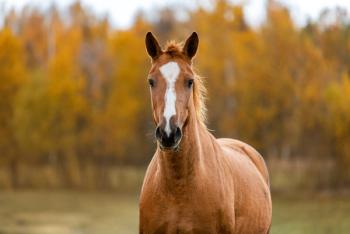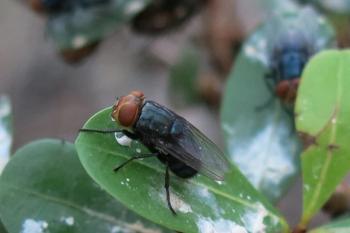
Ovulation-inducing drugs beneficial when used in 'proper context'
Practitioners should educate clients on all aspects
Breeding season is in full swing and once again those difficult situationsare starting to pop up.
The mare you are working on is in Florida. The stallion she is to bebred to is in New York. That particular stallion's shipped semen is reallyonly good for about 36 hours, so, with shipping figured in, you do not havemuch room for error and would really like to be inseminating close to ovulation.
The stallion you manage is fully booked, leaving little room for re-breeds,so you are under pressure to increase timely first service; or the studfarm will only collect on alternate days and you may be getting the sementoo soon or too late; or there are three mares, all cycling with folliclesat different stages, for a stallion that is very difficult to collect. Youwould like to make one collection, split the semen, inseminate, and havea reasonable chance of getting these mares pregnant.
These are very familiar problems for this time of year and situationsthat can mean success or failure for your client's breeding program.
Drug response
Veterinarians have responded to these situations by using various drugsto influence a mare's cycle.
The standard agent used to induce or "speed up" ovulation hasbeen hCG or human chorionic gonadatropin. This drug is given to mares withenlarging follicles and it serves to hasten the process of ovulation. Mareswith follicles close to 40 mm or larger are often given this drug, and ovulationis generally expected within 48 hours. Many mares will ovulate sooner andsome will ovulate later, so the practitioner must still try to inseminateas close to ovulation as possible. Wait too long and you've missed her.Inseminate too soon and she must be re-bred. Standard practice is to examinemares repeatedly and, when a follicle reaches appropriate size, to inseminateand give that mare hCG.
The mare must then be examined to ensure that ovulation occurs withinthe typical 48-hour window of sperm viability. If ovulation does not occurin that timeframe, then the mare must be re-bred.
Proven success
Human chorionic gonadatropin has been used successfully for many yearsand most practitioners feel comfortable with its use. Mares must be availablefor frequent ultrasound examinations for this protocol to work, however,and some mares can become refractory to repeated hCG use.
In 1999, the drug deslorelin acetate was approved for use in the UnitedStates. Deslorelin is a subcutaneous implant of a GnRH agonist marketedby Fort Dodge Animal Health under the name Ovuplant.
This drug was introduced with the claim that most mares would ovulatewithin a much smaller interval and that breeding could therefore be moretightly controlled.
Mares with a follicle greater than or equal to 35 mm in diameter willovulate not sooner than 36 hours and generally not longer than 48 hoursafter administration of Ovuplant. And the reported numbers seem to backup these claims. Because different studies use different numbers of maresand different evaluation criteria, the actual percentages vary, but FortDodge reports that approximately 2 percent of mares given Ovuplant willovulate within 36 hours of implantation. Between 86 and 95 percent of treatedmares will ovulate between 36 and 48 hours and 5 to 10 percent of such mareswill ovulate later than 48 hours post treatment.
This dramatic increase in the number of mares that will ovulate withina specific time post-treatment (between 36 and 48 hours) is the key pointin the potential usefulness of this drug.
Palpation of a follicle greater than or equal to 35 mm allows the veterinarianto administer Ovuplant to the mare and then schedule breeding within thenext 48 hours. Roughly 90 to 95 percent of these mares will ovulate withinthat timeframe and the DVM's job of ensuring that sperm and egg are presentat the same time will have been done. Hopefully, a pregnancy will be theresult of this crucial timing.
According to Drs. J. Morehead and T. Blanchard, many breeding farms actuallyprefer to administer ovulation-inducing drugs after the mares have beenbred. Unforeseen problems such as injuries to stallions, semen shipmentsdelayed in the mail, trailering problems and so forth can occasionally preventa scheduled breeding. If drugs such as Ovuplant and hCG are not given untilafter breeding, then the likelihood of a mare ovulating too soon is eliminated.
Rumors, rhetoric
At first glance it would seem that Ovuplant would fit nicely into anyequine reproductive program and may help improve the efficiency of breeding.However, following its first year of commercial use in the United Statesduring 1999 some important information about deslorelin started to becomeavailable and the controversy began.
Researchers in Kentucky began reporting that some mares treated withOvuplant that did not become pregnant on their first cycle showed a prolongedreturn to estrous. Reports of 35-day cycles began to appear. Some mareswere rumored to have shut down completely and many practitioners thereforeturned away from Ovuplant use. As usual, the truth lies somewhere betweenthe rumors and the rhetoric.
Since that first year, much has been uncovered about the actual useand effects of deslorelin. Numerous studies have shown that deslorelin acetateadministration is associated with decreased follicle stimulating hormone(FSH) during the diestrous period following ovulation.
Drs. McCue, Farquhar and Squires of the Equine Reproductive Laboratoryat Colorado State University have stated that this decreased FSH serum concentrationmay lead to decreased follicular development and a delay in the subsequentemergence of a dominant follicle. This produces an increase in the timerequired for return to estrus. Their study showed that Ovuplant treatedmares had an average interovulatory interval of 25.6 days compared to 22.9days for mares not given deslorelin.
A similar study by Drs. Morehead and Blanchard showed that 80 percentof Ovuplant treated mares had cycles of 18-25 days while 97 percent of untreatedmares had cycles of that length. Nineteen percent of deslorelin treatedmares had cycles longer than 25 days and no untreated mares had cycles thatlong.
These two studies point out two facts. Treatment with Ovuplant seemsto delay return to estrus in mares and there are numerous ways to measureand report this observation so the actual numbers may vary. Fort Dodge'sown studies confirm that there is a delay of two to five days in returnto estrus when mares are treated with Ovuplant.
Dr. Paul Schober of Peptide Animal Health in Australia takes a more practicalapproach to this information.
As a proponent of Ovuplant, Schober feels that "a few days delayin return to estrous is the consequence of using a drug that may be ableto help a veterinarian better time an important breeding and obtain a pregnancy."
While the consequences of delayed return to estrous and lost breedingtime cannot be overlooked, Schober feels that the pluses and minuses ofOvuplant use must be weighed for each individual mare and each situation.
Dr. R. Holder of Haggard, Davis and McGee in Lexington, Kentucky agreesand states that, "essentially it is a good product that works but itdoes have a side-effect (prolonged return to estrus)."
A few days delay in return to estrus may be an acceptable "consequence"of this product's use, but what of those mares showing cycles of 30 daysor more?
Schober addressed this question and pointed to research at numerous farmsthat showed that there was a small percentage of mares that had severelyprolonged cycles (greater than 30 days) regardless of treatment.
One Standardbred farm in Maryland reported that five untreated maresout of 200 horses had cycles of longer than 30 days. Mares treated withOvuplant showed tremendous variation in the percentage of severely prolongedcycles. One Thoroughbred farm in Kentucky reported no cycles over 25 dayswhile one Standardbred farm also in Kentucky reported 30 percent of mareswith cycles over 25 days.
Researchers have been searching for some other factor or factors thatmay explain this variability. None has been identified to date. Schoberfeels that perhaps the mares selected for these studies are a "biased"population. To explain, he uses the example of a farm with 100 broodmares.Of these horses roughly 20 percent are "problem breeders" forwhatever reason. All of the mares are given Ovuplant and bred on their firstcycle. Using a generous figure, assume 70 percent become pregnant. Thisleaves 30 open mares, of which, he feels, likely almost 15 may be from theoriginal 30 problem mares.
The statistics for return to cycle then include a high percentage ofmares that have some problem unrelated to Ovuplant use. To carry this thoughtout one more cycle, Schober assumes that 20 mares become pregnant out ofthe 30. This leaves 10 mares of which, it is likely all 10 are original"problem" mares. Any information for the next cycle will be froma very selective population that may have any number of factors influencingreturn to estrus.
Schober backs up this analysis with data from field studies on a numberof farms which show that the percentage of mares with excessively prolongedreturn to estrus does not vary between treated and non-treated horses.
"The very long ones are always there," says Schober.
Other interesting facts
A few other interesting facts have been brought up concerning deslorelin.
No research has shown that Ovuplant use has actually "shut down"cycles in the horse and Schober confirms that one would have to use morethan 10 times the dose to fill all the receptors and get enough "downregulation" of FSH to effectively shut down ovarian cyclical activity.
Research in this area of Ovuplant pharmacology may well lead to a productthat is of benefit to equine practitioners in a totally different way. Studiesare under way that may produce a product that can be used in show horsesto keep them from cycling during the show season. Many progesterone-basedproducts are currently available for this purpose but they are not alwayseffective for certain mares.
Injectable Depo-Provera and progesterone implants may not last very longin some mares and liquid progesterone requires daily handling and dosage.
The development of a deslorelin implant that can effectively stop cyclicalactivity may be beneficial and well accepted by certain sections of thehorse show community.
Ultimate goal
The ultimate goal of the equine veterinarian during breeding season isto get mares bred.
No one works on a broodmare thinking about her return to estrus. Positivethinking would say that she would get pregnant the first time. But thisis not always true and attention must be paid to the consequences of a returnto estrus.
Deslorelin is a beneficial product when used in the right context andwhen the potential problem of longer cycles associated with its use hasbeen taken into account. The argument over Ovuplant use should no longerbe whether it causes prolonged return to estrus or not, or exactly how manydays longer that estrus is. These questions have been reasonably answered.The only argument now is whether this drug is appropriate for your particularsituation
Holder's advice, perhaps, sums up the best approach to Ovuplant use.
"It is a good product," he states. He cautions, however, thatclients must be counseled on its possible downsides. End of argument.
Newsletter
From exam room tips to practice management insights, get trusted veterinary news delivered straight to your inbox—subscribe to dvm360.






